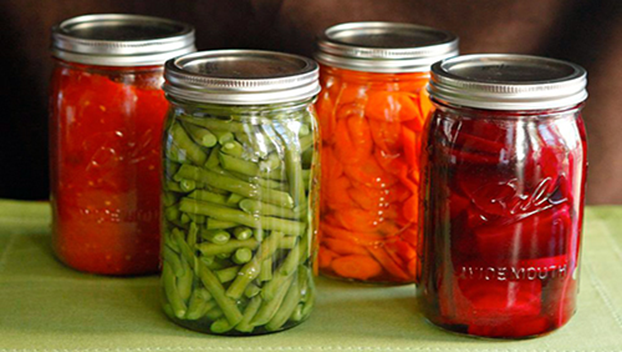Plan ahead for home canning this summer
Published 12:39 pm Thursday, April 22, 2021

- Photo submitted by Louise Hinsley.
|
Getting your Trinity Audio player ready...
|
If you are thinking about joining the trend in our communities to can food this summer, you might want to take a home canning class. Louise Hinsley, Extension Agent, Family Consumer Sciences will be teaching free classes for home canning at the Beaufort County Extension Center in the Demonstration Kitchen. The first class is a pickling class and it will be held on May 6 from 10 a.m. to 12 p.m. and will be repeated that evening from 6 p.m. to 8 p.m. The pickling class demonstration will teach about boiling water bath canning which is used for shelf storage of high acid foods only (pickles, jams and jellies). The second class is a pressure canning class for low acid foods and it will be held on May 20 from 10 a.m. to 12 p.m. and will be repeated that evening from 6 p.m. to 8 p.m. You may call the Beaufort County Center at 252-946-0111 to register for the class and specific time you wish to attend. These classes are for home canning only. If you want to sell canned food you must contact NCSU Department of Food, Bioprocessing and Nutrition Science at https://fbns.ncsu.edu/extension_program/programs.html. They will assist you with food business including certification and training that you must have to sell food prepared in your home.
If you have canned before, you know the first place to start is by checking your equipment and supplies before you have fresh produce ready to preserve. Proper equipment in good condition is required for safe, high quality home canned food. If you have a glass top range you will need to check the oven/range manufacturer’s information to determine if you can use a pressure canner on that glass-top. I know from personal experience that Presto does make a pressure canner that may safely be used on most glass-top ranges without breaking the glass-top.
The acidity of foods determines how they must be processed for canning. We don’t expect you to know your food’s pH. But the amount of acid is all it comes down to. Low-acid foods such as vegetables and meats with a pH above 4.6 must be processed in a pressure canner. Acid foods such as berries and pickles with a pH of 4.6 or lower may be canned in a water bath canner. A pressure canner is essential for canning low-acid vegetables and meats. I need to stress this means to safely preserve green beans, corn, butterbeans, potatoes and all meats, fish, and poultry in canning jars you must process in a pressure canner following every step in the manufacturer’s instructions and with an recommended tested recipe. The tested recipe will tell you which type of canner to use, the specific length of time to process (as each food varies in velocity and density and the size of the jar) as well as the headspace to leave as fill the jars.
Why? Pressure canning is the only safe way to preserve “low-acid” foods to eliminate the harmful bacteria Clostridium botulinum—the cause of a deadly illness, botulism. You cannot see, smell or taste this harmful bacteria. It thrives as it multiples over and over in a low-acid anaerobic environment, which means without oxygen. Furthermore, Clostridium botulinum is not killed at the boiling point (212 degrees Fahrenheit.) regardless how long you boil it. You must raise the internal temperature inside the canning jar above 240 degree Fahrenheit for a specific length of time based on the food and the size of the jar. To do this you must use a pressure canner. Thus, we strongly recommend following every step in a tested recipe for all canning. If you are thinking I have always had my jars to seal and we never got sick consider yourself very lucky. Just because the lid sealed on your green beans canned in a boiling water bath doesn’t mean they are safe from potential Clostridium botulinum. Again, all low-acid vegetables including artichokes, asparagus, green beans, lima beans, carrots, corn, mushrooms, okra, onions, peas, potatoes, pumpkin and winter squash as well as all meats including chicken, beef, pork, seafood, all soups, stock, all stews and other animal meats must be processed in a pressure canner to safely preserve in canning jars.
Two basic types of pressure canners are available. One has a dial gauge to indicate the pressure inside the canner; the other has a metal weighted gauge. Dial gauges must be tested for accuracy before each canning season. For information on testing a dial gauge, please contact Louise Hinsley, Beaufort County Extension Family Consumer Science Agent, 252-946-0111. Check the rubber gasket if your canner has one; it should be flexible and soft, not brittle, sticky or cracked. Also make sure any small pipes or vent ports with openings are clean and open all the way through.
A boiling water canner is needed for canning acid foods such as fruits, pickles, jellies and jams. The canner should be deep enough to allow at least one to two inches of water to boil over the tops of the two piece lids on the canning jars. A tested recipe is highly recommended for canning in a boiling water bath, too.
Both types of canners should have a rack in the bottom to keep jars off the bottom of the canner.
Inventory your jars and decide if you need to buy new jars this year. Inspect those you have for nicks, cracks or chips, especially around the top sealing edge. Nicks can prevent lids from sealing. Very old jars can weaken with age and repeated use; they break under pressure and heat. Consider investing in new jars if you need to, and watch for specials at the stores. New jars are a better investment over time than buying used jars at yard sales or flea markets. However, you may need to seek online as canning supplies are low midst the pandemic.
Mason-type jars specifically designed for home canning are best. Jars that use two-piece self-sealing metal lids are the only recommended container in USDA guidelines. A “must” every canning season is new flat lids. Used lids should be thrown away. The screw bands are re-usable if they are not bent, dented or rusted.
A final must is reliable, up-to-date canning instructions. Publications and information are available at your county Extension office, or on this website https://nchfp.uga.edu/how/can_home.html for the National Center for Home Food Preservation. The current edition of the USDA Complete Guide to Home Canning is on www.homefoodpreservation.net. The University of Georgia Cooperative Extension Service also sells So Easy to Preserve, a comprehensive book with information on all types of home food preservation. The order form for the book can be printed from www.soeasytopreserve.com. Directions for payment and mailing or faxing orders are on that order form.
Be sure to look at the instructions for what you want to can well before you are ready to prepare the food. You may need time to purchase some ingredients and small equipment that are necessary to prepare food exactly as the directions indicate.
Planning ahead can save you time, money, and frustration with home canning. Make it a happy, successful canning season by getting prepared before your harvest is ready.
Sources for this article NC Extension Food and Nutrition and the National Center for Home Food Preservation. For more information about the Foods and Nutrition please contact Louise L. Hinsley, Extension Agent, Family Consumer Science at the Beaufort County Center of NC Cooperative Extension, 155 Airport Road, Washington, 252-946-0111.





